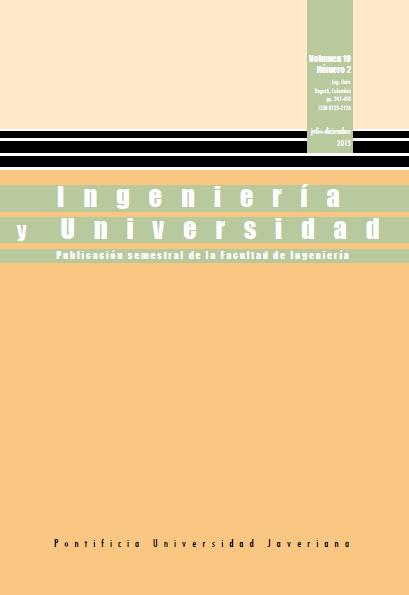Abstract
Wear on sugar cane rolls is an expensive maintenance problem for the sugar cane industry. Wear produces loss of sucrose extraction and loss of grip of the roll on the bagasse. This paper presents the evaluation of wear and loss of grip of hypoeutectic and hypereutectic high chromium welding deposits applied on ASTM A-36 steel and gray cast iron. A modified ASTM G-65 standard test was used. Wear was produced by the abrasive action of wet bagasse with three levels of mineral extraneous matter. Silica grains with sizes in the range of 0.212-0.300 mm (AFS 50/70) were used as mineral extraneous matter. Grip was evaluated by measuring the torque on the power transmisión shaft that moves the specimens. Worn surfaces were characterized by using scanning electron microscopy. Wear was found to increase proportionally related to the mineral extraneous matter content. Geometric changes of the Weld deposits related to wear caused grip loss. For low mineral extraneous matter level, wear resistance of carbon steel was greater than that of gray cast iron; whereas the opposite was found for high mineral extraneous matter level.
[2] V. E. Buchanan, P. H. Shipway and D. G. Mccartney, “Microstructure and abrasive wear behavior of shielded metal arc welding hardfacing used in the sugarcane industry”, Wear, vol. 263, pp. 99-110, 2007.
[3] Y. Aguilar, F. Casanova, R. Victoria, D. Aguirre y B. Uquillas, “Desgaste en acero de bajo carbono debido a la acción de bagazo limpio o contaminado con sílice y jugo de caña”, Ingeniería y Universidad, vol. 15, no. 2, pp. 373-384, 2011.
[4] R. Victoria, B. Uquillas, J. Y. Aguilar, Y. Aguilar and F. Casanova, “Abrasive wear effect of sugarcane juice on sugarcane rolls”, Wear, vol. 270, pp. 83-87, 2010.
[5] S. Kroes, “Enhanced roll life”, Proc. Aust. Soc. Sugar Cane Technol, vol. 21, pp. 307-312, 1999.
[6] L. Durán, Y. Aguilar, O. Hernández, R. Victoria y F. Casanova, “Efecto de la geometría de los depósitos de soldadura de recubrimiento en el desgaste de acero bajo al carbono en contacto con bagazo de caña de azúcar”, Ingeniería y Universidad, vol. 17, no. 1, pp. 117-141, 2013.
[7] V. Buchanan, “Solidification and microstructural characterisation of iron-chromium based hardfaced coating deposited by SMAW and electric arc spraying”, Surface & Coatings Technology, vol. 203, pp. 3638-3646, 2009.
[8] M. Filipovic, Z. Kamberovic, M. Korac and M. Gavrilovski, “Microstructure and mechanical properties of Fe-Cr-C-Nb white cast irons”, Materials and Design, vol. 47, pp. 41-48, 2013.
[9] P. Mendez, N. Barnes, K. Bell, S. Borle, S. Gajapathi, S. Guest, H. Izadi, A. Gol and G. Wood, “Welding processes for wear resistant overlays”, Journal of Manufacturing Processes, vol. 16, pp. 4-25, 2014.
[10] V. E. Buchanan, P. H. Shipway and D. G. Mccartney, “A comparison of the abrasive wear behavior of iron-chromium based hardfaced coatings deposited by SMAW and electric arc spraying”, Wear, vol. 264, pp. 542-549, 2008.
[11] N. Yuksel and S. Sahin, “Wear behavior-hardness-microstructure relation of Fe-Cr-C and Fe-Cr-C-B based hardfacing alloys”, Materials and Design, vol. 58, pp. 491-498, 2014.
[12] R. Zahiri, R. Sundaramoorthy, P. Lysz and C. Subramanian, “Hardfacing using ferro-alloy powder mixtures by submerged arc welding”. Surface & Coatings Technology, in press.
[13] C. M. Downing, S. A. Loughran and S. A. Domanti, “Crushing soil contaminated sugar cane”, Proc. Aust. Soc. Sugar Cane Technol, vol. 21, pp. 294-300, 1999.
[14] D. Aguirre y H. Castañeda, “Sinergia abrasión-corrosión dada en los molinos de caña producida por el bagazo y el jugo de la caña”, tesis de pregrado, Universidad del Valle, Cali, Colombia, 2009.
[15] A. Misra and I. Finnie, “Some observations on two-body abrasive wear”, Wear, vol. 68, pp. 41-56, 1981.
[16] J. J. Coronado and A. Sinatora, “Effect of abrasive size on wear of metallic materials and its relationship with microchips morphology and wear micromechanisms: Part 1”, Wear, vol. 271, pp. 1794-1803, 2011.
This journal is registered under a Creative Commons Attribution 4.0 International Public License. Thus, this work may be reproduced, distributed, and publicly shared in digital format, as long as the names of the authors and Pontificia Universidad Javeriana are acknowledged. Others are allowed to quote, adapt, transform, auto-archive, republish, and create based on this material, for any purpose (even commercial ones), provided the authorship is duly acknowledged, a link to the original work is provided, and it is specified if changes have been made. Pontificia Universidad Javeriana does not hold the rights of published works and the authors are solely responsible for the contents of their works; they keep the moral, intellectual, privacy, and publicity rights.
Approving the intervention of the work (review, copy-editing, translation, layout) and the following outreach, are granted through an use license and not through an assignment of rights. This means the journal and Pontificia Universidad Javeriana cannot be held responsible for any ethical malpractice by the authors. As a consequence of the protection granted by the use license, the journal is not required to publish recantations or modify information already published, unless the errata stems from the editorial management process. Publishing contents in this journal does not generate royalties for contributors.


